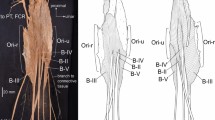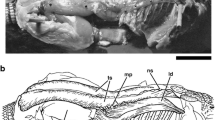Summary
Because our practical experience concerning the characteristic features of the peroneus III muscle disagreed with the usual statements and illustrations in anatomical text-books, we reexamined the gross anatomy of this muscle.
A total of 157 peroneus III muscles was present in 169 lower limbs. Thus, the absence of this muscle (in 7.1% of our specimens) should be considered the variation rather than its presence. Moreover, the peroneus III has an identity separate from that of the extensor digitorum longus, and frequently is as large as or even larger than the extensor digitorum longus. Thus, the origin of the peroneus III extends much more proximally than stated in most text-books. It is a semipennate muscle with a tibially sited tendon, and therefore resembles the fibular and distal part of the extensor digitorum. This part of the extensor digitorum overlaps the extensor hallucis longus and is in turn overlapped by the peroneus III. The more proximal and tibial part of the extensor digitorum is arranged in a slender belly with its fasciculi converging towards a centrally sited tendon of considerable length. The proximal part of the extensor digitorum longus gives rise to slips to the medial toes, and the distal part to the lateral toes. The attachment of the peroneus III tendon is usually trifurcate, with one projection towards the tubercle and the dorsolateral aspect of the fifth metatarsal bone, another to the dorsomedial border of the same metatarsal bone, and a third projection to the base of the fourth metatarsal bone. An accessory slip to the dorsal aponeurosis of the fifth toe was found to occur only rarely.
The usual description that the peroneus III is only a part of the extensor digitorum longus, or even its fifth tendon, should therefore be revised. The functional and evolutionary significance of this muscle is discussed, because the peroneus III occurs only in man, and in the gorilla alone of the anthropoid apes as well as of all other primates.
Similar content being viewed by others
References
Albinus, B.S.: Explicatio tabularum Bartholomaei Eustachii, anatomici summi. Accedit, Tabularum editio nova. Leidae Batavorum: 1744
Benninghoff, A., Goerttler, K.: Lehrbuch der Anatomie des Menschen. (Ferner, H. and Staubesand, J. eds.) Vol. I: Allgemeine Anatomie, Cytologie und Bewegungsapparat. 11th Edn. München-Berlin-Wien: Urban & Schwarzenberg 1975
Boyer, E.L.: The musculature of the inferior extremity of the Orang-Utan Simia Satyrus. Amer. J. Anat. 56, 193–256 (1935)
Braus, H., Elze, C.: Anatomie des Menschen. Vol. I: Bewegungsapparat. 3rd Edn. Berlin-Göttingen-Heidelberg: Springer 1958
Cowper, W.: Myotomia reformata: Or an anatomical treatise on the muscles of the human body. London 1724
Elftman, H., Manter, J.T.: The axis of the human foot. Science 80, 484 (1934)
Gray, E.G., Basmajian, J.V.: Electromyography and cinematography of leg and foot (“normal” and flat) during walking. Anat. Rec. 161, 1–16 (1968)
Hafferl, A.: Lehrbuch der topographischen Anatomie des Menschen. (Thiel, W., ed.) 3rd rev. Edn. Berlin-Heidelberg-New York: Springer 1969
Henle, J.: Handbuch der systematischen Anatomie des Menschen. Vol. I/3: Muskellehre. Braunschweig: Vieweg & Sohn 1858
Hepburn, D.: The comparative anatomy of the muscles and nerves of the superior and inferior extremities of the anthropoid apes. Part II. Myology of the inferior extremity. J. Anat. Physiol. 26, 324–356 (1892)
Hicks, J.H.: The mechanics of the foot. IV. The action of muscles on the foot in standing. Acta anat. 27, 180–192 (1956)
Hyrtl, J.: Lehrbuch der Anatomie des Menschen. Mit Rücksicht auf physiologische Begründung und praktische Anwendung. 7th Edn. Wien: Braumüller 1862
Keith, Sir A.: The adaptational machinery concerned in the evolution of the man's body. Nature (London) 112, 257–268 (1923)
Lanz, T.v., Wachsmuth, W.: Praktische Anatomie. (Lang, J. and Wachsmuth, W., eds.) Vol. I/4: Bein und Statik. 2nd rev. Edn. Berlin-Heidelberg-New York: Springer 1972
Lenneberg, E.H.: Biological foundations of language. New York: Wiley 1967
Morton, D.J.: The peroneus tertius muscle in gorillas. Anat. Rec. 27, 323–329 (1924)
Preuschoft, H.: Muskeln und Gelenke der Hinterextremität des Gorillas (Gorilla gorilla Savage et Wyman, 1847). Morph. Jb. 101, 432–540 (1961)
Preuschoft, H.: Statische Untersuchungen am Fuß der Primaten. II. Statik des ganzen Fußes. Z. Anat. Entwickl.-Gesch. 131, 156–192 (1970)
Rauber, A., Kopsch, F.: Lehrbuch und Atlas der Anatomie des Menschen. (Bargmann, W., Leonhardt, H. and Töndury, G., eds.) Vol. I.: Bewegungsapparat. 20th rev. Edn. Stuttgart: Thieme 1968
Ribbing, L.: Die Muskeln und Nerven der Extremitäten. In: Handbuch der vergleichenden Anatomie der Wirbeltiere. (Bolk, L., Göppert, E., Kallius, E. and Lubosch, W., eds.) Vol. V. Berlin-Wien: Urban & Schwarzenberg 1938
Ruge, G.: Untersuchungen über die Extensorengruppe am Unterschenkel und Fusse der Säugethiere. Morph. Jb. 4, 592–643 (Suppl.), (1878)
Schwalbe, G., Pfitzner, W.: Varietäten — Statistik und Anthropologie. 3. Mitteilung. In: Morphologische Arbeiten. (Schwalbe, G., ed.) Vol. III. Jena: Fischer 1894
Stelzner, F.: Der Fuß in Stand und Marsch. Z. Anat. Entwickl.-Gesch. 112, 229–244 (1942)
Töndury, G.: Angewandte und topographische Anatomie. 4th rev. Edn. Stuttgart: Thieme 1970
Vesalius, A.: De corporis humani fabrica libri septem. Liber II. Basileae: 1555
Waldeyer, A.: Anatomie des Menschen. Vol. I: Allgemeine Anatomie, Rücken, Bauch, Becken, Bein. (Mayet, A., ed.) 12th Edn. Berlin-New York: Walter de Gruyter 1975
Warwick, R., Williams, P.L.: Gray's Anatomy. (eds.) 35th Edn. Edinburgh: Longman 1973
Winslow, J.B.: Expositio anatomica structurae corporis humani. Tomus I, Francofurti-Lipsiae: Joan. Gothofr. Baueri 1753
Young, J.Z.: An introduction to the study of Man. Oxford: Oxford university press 1971
Author information
Authors and Affiliations
Additional information
Dedicated to Prof. Dr. Drs. h.c. mult. Paul A. Weiss, who enjoyed our reflections on the function of the peroneus III, and therefore stimulated this paper
Rights and permissions
About this article
Cite this article
Krammer, E.B., Lischka, M.F. & Gruber, H. Gross anatomy and evolutionary significance of the human peroneus III. Anat Embryol 155, 291–302 (1979). https://doi.org/10.1007/BF00317642
Accepted:
Issue Date:
DOI: https://doi.org/10.1007/BF00317642




